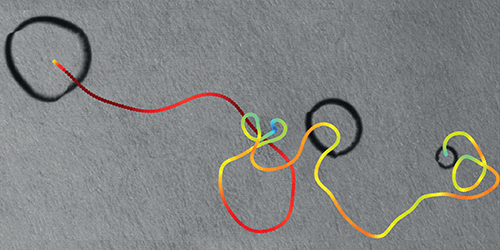Hot Surfaces Make Droplets Move Erratically
Drop a small amount of ethanol, a volatile liquid, onto your hand and it will likely spread into a thin film before quickly evaporating. Now Pallav Kant of the University of Twente, Netherlands, and his colleagues show that on such surfaces—ones that are warmer than room temperature but colder than the boiling point of ethanol—droplets of this liquid can remain spherical and move across the surface, following seemingly erratic paths [1]. The researchers attribute this behavior to the development of a heat-driven, unstable fluid flow inside the droplet. They say that this phenomenon could be behind the imprecise deposition of droplets during processes such as ink-jet printing.
To study the problem, the researchers dripped a 4-µl droplet of ethanol onto a heated sapphire surface and watched what happened. For surfaces heated to between 35 °C and 45 °C, the liquid contracted into a spherical-cap-shaped droplet and then stood motionless. For surfaces heated above 45 °C, the liquid also contracted into a hemispherical droplet but then danced across the surface along a random trajectory. The velocity of the droplet increased with the surface’s temperature, and its shape became rounder. This self-propulsion continued until the droplet completely evaporated, which took a few tens of seconds.
Looking next at the droplet surface, the researchers used infrared imaging to reveal complex surface patterns, which they associated with the unstable flow inside the droplet. These patterns indicated the presence of an asymmetric flow inside the droplet, which provided the directional force sufficient to propel it. The researchers conclude that this self-propulsion mechanism is different from other self-propulsion mechanisms, as the driver of the motion is intrinsic rather than extrinsic to the droplet.
–Rachel Berkowitz
Rachel Berkowitz is a Corresponding Editor for Physics Magazine based in Vancouver, Canada.
References
- P. Kant et al., “Autothermotaxis of volatile drops,” Phys. Rev. Fluids 9, L012001 (2024).




